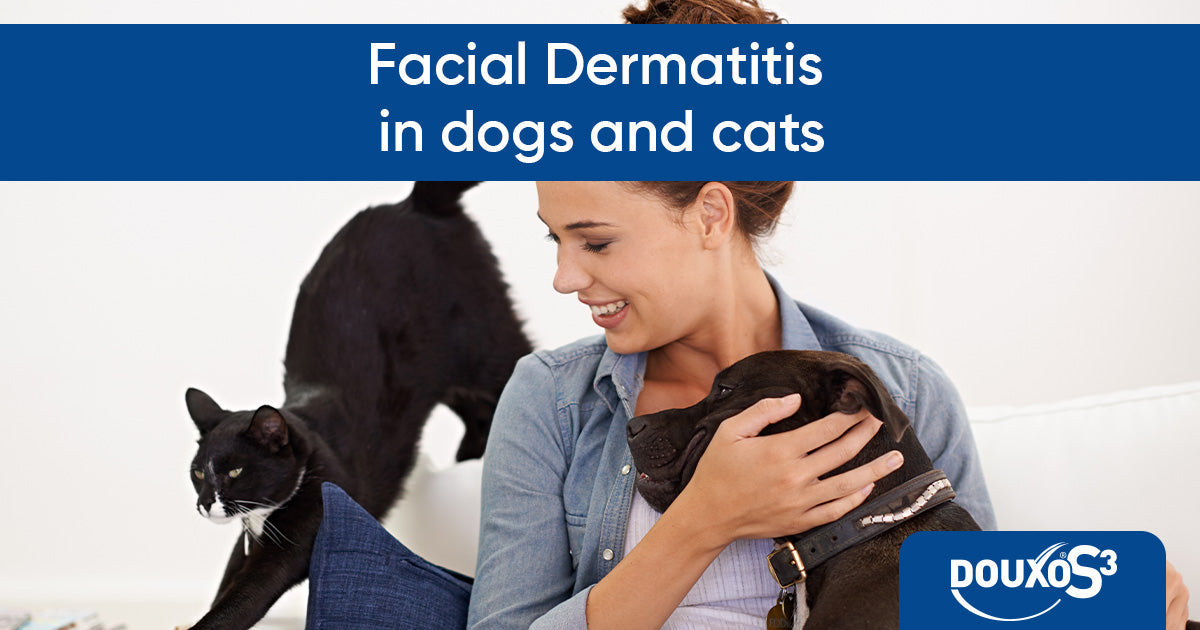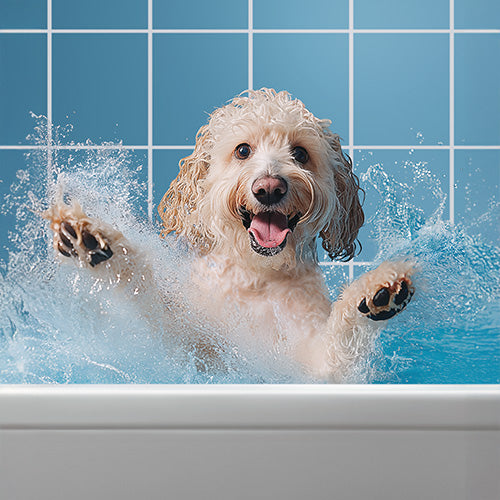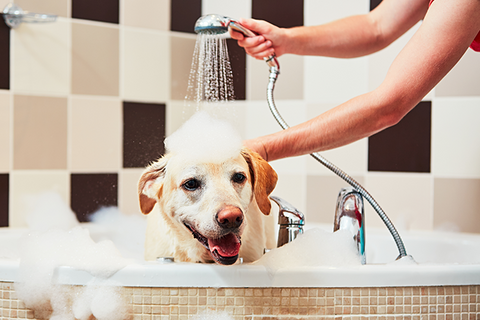
Facial dermatitis in dogs and cats
Our furry friend comes toward us with those sweet, kind eyes seeking our attention. We go straight away to hug them but wait! What is this? Is that area bold? Why is the face stinky? What is happening? Your vet tells you your dear pet suffers from facial dermatitis. Let’s learn about it.
The term facial dermatitis refers colloquially to any cutaneous sign happening on the face, although the term “dermatitis” should only be used when there is an inflammatory cause. Those are common conditions that affect many dogs and cats at some point in their lives and could cause recurring life-long disease. The face can be a sensitive area, so facial dermatitis can be challenging to treat, especially life-long conditions that require ongoing skin care. However, many pets with facial dermatitis can be successfully managed with topical treatments alone.
Are all facial dermatitis the same?
Many different types of skin diseases will cause skin lesions over your pet’s face, muzzle, and ears, (we won’t enter to discuss ear dermatitis as they have several entries for them )(LINK), while others cause generalized skin signs also over other parts of your pet’s body.
Diagnosing facial dermatitis can be tricky, as those many diseases result at the end in very similar lesions on your dog or cat’s face. . As it may come from different origins, the manifestations are also different, from just a sore and reddened skin to fluid-filled vesicles and alopecia, together or not with itchiness and stinky skin. Frequently, your vet will advise performing further diagnostics, including cytology, and maybe taking skin biopsies to get an accurate diagnosis .
Skin disease is often easier to treat the earlier it is detected, so if you notice any skin changes on your pet’s face, you should seek veterinary advice early so treatment can be started.
Diseases that cause facial dermatitis (and more)
There are many different skin conditions that cause facial dermatitis in cats and dogs., Facial dermatitis can also vary from mild signs that can be difficult for owners to detect to severe signs that owners may find very distressing. Among the diseases that are restricted to the face, your pet can have been diagnosed with feline or canine chin acne, indolent ulcers in cats, or “dirty face”, also in cats. Unfortunately, a good bunch of other diseases found in the face can be extended or found in other localizations. This is the case of dermatophytosis (ringworm), demodicosis, skin tumors, atopic dermatitis, skin fold dermatitis, and autoimmune diseases such as pemphigus foliaceus.
We will stop briefly at some of the more relevant. You will find some familiar names!
Feline acne and canine acne
Acne can cause dark spots to develop on the lower lip and chin of both dogs and cats. This may be accompanied by dried, scaly, or crusty skin. Acne does not usually irritate affected pets unless a secondary bacterial infection or abscess develops, when owners may see pus-filled spots and drainage tracts develop.
Dermatophytosis
Dermatophytosis is more commonly known as ringworm, though it is caused by fungi and not a worm as the name suggests. It is a zoonotic condition, so owners can potentially develop the disease after contact with infected pets, especially if they have a wound or are immunocompromised. Pets who are infected may only develop patches of scaly, dried skin, similar to other skin disease, making it a challenging condition to diagnose. Lesions can also develop anywhere on the body, but the face is frequently affected. Kittens of unknown origin presented to the vet with bold or scaly lesions in the face, could have ringworm, under proven otherwise.
Demodicosis
Demodex canis is a mite that lives deep in the hair follicles and is a typical inhabitant of healthy dogs and cats. However, if too many mites are present, they can cause generalised or focal skin disease in dogs and cats. Dogs are most frequently affected, and it can occur at the same time as other diseases which have led to mite overgrowth, such as hormone disorders. While Demodex can cause a range of clinical signs, from widespread hair loss to localised disease, it can also cause facial dermatitis in both dogs and cats. Frequently, reddened skin, hair loss and dandruff are seen around the face, and infected pets can be itchy if there is secondary infection. Many dogs develop bald patches due to demodicosis, some of which can be self-resolving as the immune system matures.
“Dirty face”
This feline exclusive skin condition most commonly affects Persian cats and other long-haired breeds. It can be distressing for owners to see, as black crusts and dark discharge form around the eyes, nose, mouth, and chin, causing the appearance of a dirty face, though it is not thought to be itchy or irritating unless a secondary skin infection also develops. This condition will affect your cat for the rest of their life, so long-term skin care is needed to keep your pet’s face clean and to help prevent future skin infections.
Pemphigus foliaceus
This is an immune-mediated skin disease that affects both dogs and cats. Frequently, pus-filled spots develop on the face, including the nose and inside of the ear, though it can also cause generalised skin signs anywhere on the body. A skin biopsy is needed to diagnose this condition, and treatment is usually life-long, with pets often requiring immune-modulating drugs, such as steroids.
Skin fold dermatitis
Any dog with loose skin is at risk of developing skin fold dermatitis, but breeds such as English Bulldogs, French Bulldogs, Pugs and Basset Hounds are frequently affected. The moist environment found between skin folds is ideal for developing skin infections, so long-term skin care is needed to prevent skin fold dermatitis and keep the skin healthy.
Atopic dermatitis
Atopic dermatitis can cause either generalised skin disease or a focal disease that may affect specific areas, such as the face, in response to contact with an environmental or food allergen. Most frequently, when the face is involved, reddened skin around the eyes, muzzle and ears may develop as the result of self-trauma due to itching. Conjunctivitis, ear infections and a runny nose may also occur.
How to treat facial dermatitis
Topical treatments are essential when treating skin disease, as they target affected areas of the skin and can help reduce the need for systemic medications such as antibiotics. However, your pet’s face is a very sensitive area, so some topical treatments, such as shampoos, may not be tolerated or just difficult to apply. Just take into consideration that eyes are extremely delicate and by no means cutaneous products should be applied in a way that can enter or touch the eye. Be aware also of rubbing and scratching!
For pets with allergies and itchy, irritated skin, the DOUXO® S3 CALM range can help soothe the skin and make your pet comfortable. DOUXO® S3 CALM pads are essential for treating reddened skin around the eyes and muzzle, while the leave-in mousse can be applied to your pet regularly to help reduce allergy flare-ups.
The DOUXO® S3 PYO range includes easy-to-apply antibacterial pads, ideal for daily use on your pet’s face. They are great for cleaning infected and crusty skin folds and help treat skin infections while also improving the skin health. DOUXO® S3 PYO mousse and shampoo can also be used on the rest of your pet’s skin to keep it healthy and hydrated.
The use of topical treatments with antibacterial action, such as DOUXO® S3 PYO may be sufficient to treat skin infections and may avoid the need to use systemic antibiotics. However, if your pet has itchy or painful skin, your pet may need anti-inflammatory medications to help keep them comfortable while their treatment starts.
Facial dermatitis commonly affects dogs and cats, and with so many different skin conditions responsible for causing skin lesions on the face, it is important to seek prompt veterinary advice if your pet is affected. Your vet will also help you learn how to care for your pet's skin long-term to reduce the frequency of flare-ups and avoid repeated skin infections.
We recommend DOUXO® S3 CALM and DOUXO® S3 PYO
















